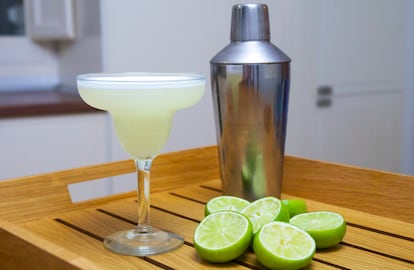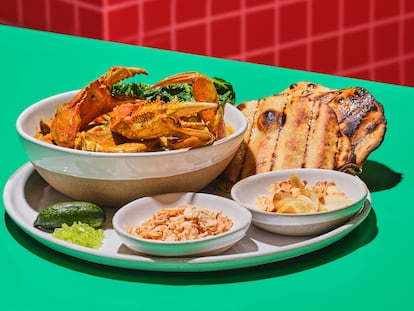Cooling off with five classic Latin cocktails
Pisco sour, a refreshing daiquiri, Cuban mojito, Mexican margarita, and a piña colada. Here are five recipes for a balanced drink that lets all the ingredients shine


So this is where we’ve got to: the signal you needed to stop drinking vodka soda at all your parties and move on to cocktails that are a little more sophisticated, a little more fun to drink. Not because the classic old fashioned, screwdriver, cuba libre or whatever you want to call it tastes bad, but maybe it has become a bit boring; especially since you’ve been drinking the same thing since that night when you started dating a long, long time ago.
Today we bring you five cocktails that are perfect for your get-togethers. Besides being refreshing and delicious, they all come from Latin America. We’ll travel to Peru for the classic pisco sour, to Cuba for a refreshing daiquiri and while we’re there, we’ll have a mojito. Continuing to Mexico, we’ll pick up a good margarita, and end up in Puerto Rico for a piña colada. They are all internationally famous cocktails, but also internationally abused: these five recipes will provide you with a balanced drink that is not too sweet and lets all the ingredients shine.
Like the whole world of drinks, cocktails are shrouded in mystery. They’re quite intimidating. But don’t let grandiloquent words and exact measurements make you dizzy: rustling up any of these five cocktails is extremely simple, and much cheaper than ordering them at a bar. Besides, telling your guests that you have prepared piña coladas will go down much better than if you send a text message asking “who’s bringing the rum and coke?”
Pisco sour
After ceviche, the pisco sour is probably the best-known example of Peruvian food and drink: a sour and refreshing drink, it wakes you up and stimulates your appetite. Pisco, for those who do not know it, is a grape brandy, similar to traditional brandy or cognac, but not ripened in wooden barrels. Although there are a few varieties, acholado is usually recommended for cocktails. It is produced with a mixture of grapes and is softer and sweeter than the stronger version, pisco quebranta.
Let’s start by making a double syrup, that is, two parts sugar and one part water: add 100 grams (4 ounces) of sugar and 50 milliliters (1.7 fluid ounces) of water to a saucepan, put it over medium heat, and mix until the sugar has dissolved. Transfer it to a jar and let it cool completely. We are going to make a single glass of pisco in a shaker, but you can multiply it as many times as you want, add all the ingredients to a blender, and make enough for all the guests you have.

Add to the shaker 60 milliliters (2 fluid ounces) of pisco, 25 milliliters (0.9 fluid ounces) of lime juice — a little less than the juice of one whole lime —15 milliliters (0.5 fluid ounces) of the syrup, and finally, 15 grams (0.5 ounces) of egg white. Weighing the egg white is a bit difficult because of its consistency, the amount is more or less a heaping tablespoon. If putting a raw egg white in a drink sounds strange, don’t be alarmed: it’s common in cocktails, so as to give them a little more texture, and above all, to create foam on top. Close the shaker and give it a dry shake (without ice) for 15 seconds.
Open the shaker, add ice cubes to fill 3/4 of the glass, and shake vigorously for 15 seconds, to create a good foam and to cool everything well. If you are preparing it in a blender, add two ice cubes for each serving of the recipe and beat them for 10 seconds. All that remains is to serve, preferably strained (you can leave the ice in if you have crushed it). Drink it as is or top it off with three drops of bitters or angostura.
Daiquiri
The daiquiri is one of those cocktails that must be enjoyed in moderation, because it is almost entirely white rum. That’s why you’re going to benefit a lot from using a good quality rum, which doesn’t taste like rubbing alcohol. Daiquiris come from Cuba, and although I don’t want you to change the way you say it — I haven’t either, after I found out — you might want to learn how “daiquiri” is really pronounced.
Again, you’ll need a shaker, but it can be made in a blender, and you can multiply the ingredients as many times as you want. As in the pisco sour, we’ll also need a double syrup: if you get into the world of cocktails, you’ll get used to having this type of preparation on hand, because they’re needed in many recipes. To the shaker add 50 milliliters (1.75 fluid ounces) of a good white rum and 15 milliliters (0.5 fluid ounces) of lime juice — the average, more or less — but before cutting it, remove a strip of peel with a peeler to garnish the drink later.
We continue with 10 milliliters (0.35 fluid ounces) of double syrup and, optionally, five drops of bitters or angostura to give it a little more complexity. Fill 3/4 of the shaker glass with ice and shake for 15 seconds. If you are using a blender, add one ice cube for each serving of the recipe you are making, and blend for 10 seconds. Serve it immediately in a glass and twist the lime peel on top, to squeeze out the oils it contains and flavor the drink (you can also decorate with a quarter of lime on the edge).
Mojito
Oh, the mojito, the legendary mojito. I said in the introduction that all these cocktails are internationally abused, but this poor man takes the cake: it’s either too sweet, it tastes like toothpaste, or it’s been diluted to death with ice. Best of all, there’s no mystery, and is far less laborious than many recipes would have you believe.
The first thing we need is a tall, wide glass, with a capacity of about 350 milliliters (13 fluid ounces). The second thing, which is important for the recipe to be a success, is crushed ice: crushed medium-sized ice cubes, which still have sharp edges, so that they do not dilute instantly and water down our mojito. Add 15 peppermint or spearmint leaves to the empty glass 15, 60 milliliters (2 fluid ounces) of rum, 10 milliliters (0.33 fluid ounces) of double syrup, the juice of half a lime (15 milliliters/0.5 fluid ounces), and the other half of the lime cut in two. Fill half the glass with crushed ice, and vigorously mix everything with a spoon, using vertical movements: we want the edges of the ice to extract the essential oils from the mint leaves and the lime peel, so you have to mix with purpose.
There are recipes that recommend crushing the leaves with sugar beforehand for optimal extraction, but I find that type of mojito too sweet and, above all, too minty (besides, the leaves look poached and ugly). Once everything is mixed, fill the rest of the glass with crushed ice, and then finish with 15 milliliters (0.5 fluid ounces) of soda — not 7up or Sprite, which are already super sweet in themselves. In case you don’t want to buy soda and you’re going to use one of those two, skip the double syrup above, to compensate for the extra sweetness. Stir the glass a couple of times with a spoon and that’s it.
Margarita
As with the daiquiri, you have to be a little careful with the margarita, because before you know it, you’ll have drunk five and you’ll be rethinking your decisions. The margarita is a classic and popular drink for a reason: it’s perfectly balanced, with an acidity that makes it addictive and refreshing, and of course, the salt around the rim of the glass, which I know has many detractors, but it drives me crazy. Let’s start there, with the salted rim: spread a little salt on a flat plate, and then, cut half a lime into quarters and moisten the outside of the glass with one of them. You have to be careful not to wet it, and especially not to do it inside the glass, because we do not want there to be too much salt either. Finally, roll the rim of the glass on the salt, and that’s it.
To make the cocktail: in a shaker add 50 milliliters (1.75 fluid ounces) of tequila, 25 (0.875 fluid ounces) each of triple dry and lime juice, and finally, two drops of a 4:1 saline solution. This ingredient is similar to the double syrup that we used in the other recipes and is used in many cocktails. Just as we add salt to food to intensify its flavors, these two drops will make the cocktail much more sophisticated. To prepare the solution, simply mix 20 grams (0.7 ounces) of salt with 80 milliliters (2.8 fluid ounces) of water in a saucepan over low heat until it has dissolved, and then cool it completely.
If you are not a fan of very acidic drinks, such as the margarita, you can balance it a little with five milliliters (1 teaspoon) of double syrup. Fill 3/4 of the shaker with ice, and shake for 15 seconds. Serve it immediately in the glass with the salted rim and enjoy.
Piña colada
“If you like Piña Coladas...” This is the cocktail that automatically transports you to summer, period. It is the favorite of many who still do not know, because if you liked the classic Malibu with pineapple, the piña colada is its adult version, for palates that are a little more demanding. We’re going to make this cocktail in a blender, because it is the only way to prepare it, so it is a great way to prepare a lot at once (the quantities in this recipe make four glasses).
The key ingredient for a good piña colada is a good pineapple juice. It costs nothing to prepare it at home: buy a ripe pineapple at the market, peel it, remove the heart and cut it into eighths, cut them into cubes and blend them with a glass of cold water for two minutes, until there are no lumps and the mixture is foamy. Then, strain it, leaving all the fiber behind.
With our homemade pineapple juice ready, let’s get to work. Add the following ingredients to the blender: 240 milliliters (8.45 fluid ounces) of white rum, 420 milliliters (14.8 fluid ounces) of pineapple juice, 60 milliliters (2 fluid ounces) of lime juice (about two limes), and eight drops of the same 4:1 saline solution that we made for the margarita, to enhance all the flavors. So much for the liquid part of the cocktail, let’s make a creamy one: add 90 milliliters (3.2 fluid ounces) of coconut milk. It’s very important that it has more than 75% coconut concentrate, since there are some that come a blend of coconut milk cut with water.
The most common ingredient for piña colada is coconut cream instead of coconut milk. It’s a condensed and sweetened version of the same. If you have difficulty finding it, you can compensate by adding two teaspoons of sugar to the coconut milk. Finally, for the creaminess of the drink, add 30 milliliters (1 fluid ounce) of cooking cream or single cream — not whipping cream — which has a percentage of fat around 18% and will give the drink its classic creaminess and nice dairy touch. Top with six heaping tablespoons of crushed ice, and beat everything for 10 seconds. Then serve it and garnish with a piece of pineapple on the edge of the glass and a straw (not plastic, it’s 2023 after all).
Sign up for our weekly newsletter to get more English-language news coverage from EL PAÍS USA Edition
Tu suscripción se está usando en otro dispositivo
¿Quieres añadir otro usuario a tu suscripción?
Si continúas leyendo en este dispositivo, no se podrá leer en el otro.
FlechaTu suscripción se está usando en otro dispositivo y solo puedes acceder a EL PAÍS desde un dispositivo a la vez.
Si quieres compartir tu cuenta, cambia tu suscripción a la modalidad Premium, así podrás añadir otro usuario. Cada uno accederá con su propia cuenta de email, lo que os permitirá personalizar vuestra experiencia en EL PAÍS.
¿Tienes una suscripción de empresa? Accede aquí para contratar más cuentas.
En el caso de no saber quién está usando tu cuenta, te recomendamos cambiar tu contraseña aquí.
Si decides continuar compartiendo tu cuenta, este mensaje se mostrará en tu dispositivo y en el de la otra persona que está usando tu cuenta de forma indefinida, afectando a tu experiencia de lectura. Puedes consultar aquí los términos y condiciones de la suscripción digital.
More information
Últimas noticias
Most viewed
- Alain Aspect, Nobel laureate in physics: ‘Einstein was so smart that he would have had to recognize quantum entanglement’
- Alvin Hellerstein, a 92-year-old judge appointed by Bill Clinton, to preside over Maduro’s trial in New York
- Gilles Lipovetsky: ‘If you want to live better and fall in love, take Prozac, don’t look to philosophy’
- Cuba confirms death of 32 of its citizens in the US attack against Venezuela
- Why oil has been at the center of Venezuela-US conflicts for decades










































